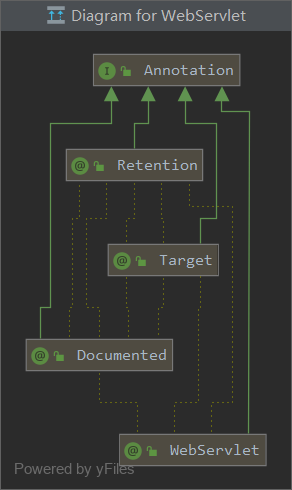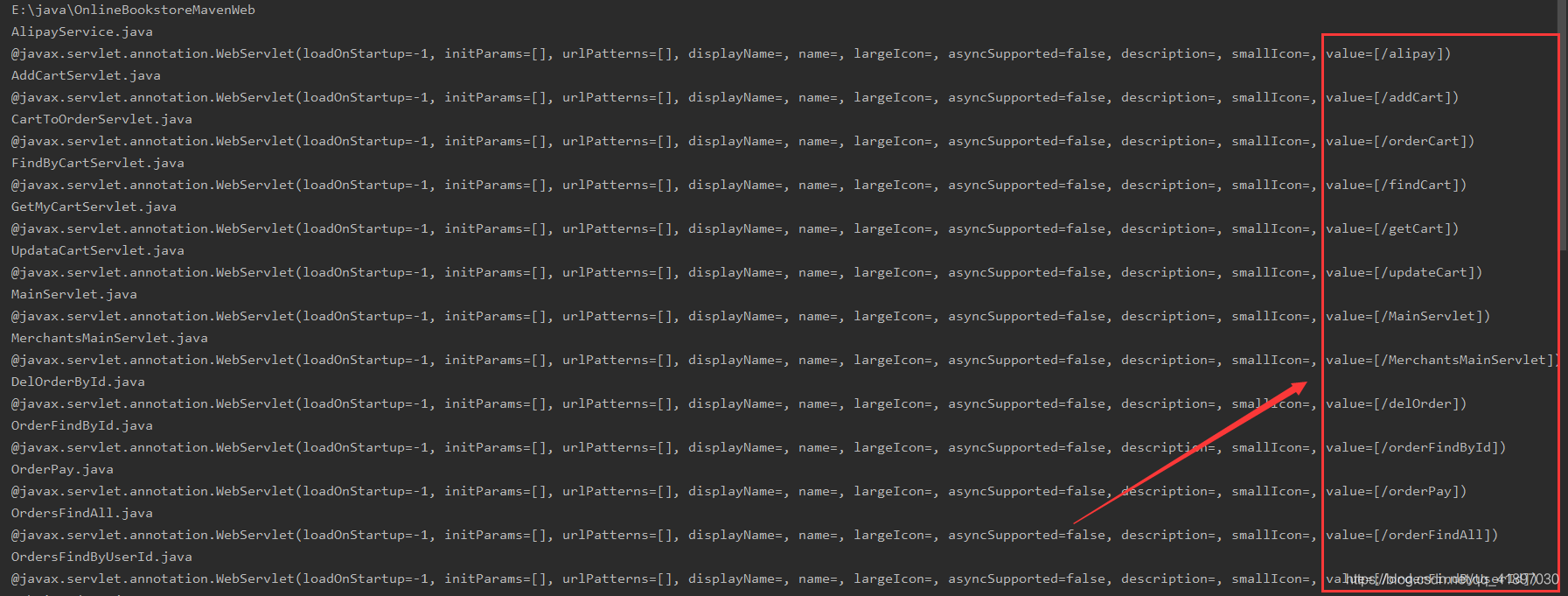
2020-05-30
1135

原创
实现在SpringBoot项目启动时对所有URL进行扫描
想对项目URL进行扫描自然离不开对应的注解。
说起注解,自然而然的就会想到Annotation,也就是java.lang.annotation.Annotation,通过观察类关系树状图

我们不难发现Annotation下有个WebServlet接口,再通过输出语句我们可以看到里面包含了我们想要的url信息,如下图

接下来为了得到WebServlet接口里面的value值也就是url,我们可以将Annotation这个接口强制转化成WebServlet
WebServlet webServlet= (WebServlet) annotation;
然后通过
String[] urls=webServlet.value();
可获得urls数组遍历一下就可以得到我们想要的url
那么如何在项目启动时获取URL呢?
步骤如下
1、声明要扫描URL的包路径
String packageName = "com.servlet.";
2、用this.getClass().getResource("/").getPath()获取类工作路径也就是classes文件路径,然后用File类获取类加载的根路径
File f = new File(this.getClass().getResource("/").getPath());
3、用创建好的File类递归获取路径下的所有类名
public void findFile(File folder, String packageName){
File[] files = folder.listFiles();
for (File file:files) {
if (file.isDirectory()) {
findFile(file, packageName + file.getName() + ".");
} else {
getUrl(file.getName(), packageName);
}
}
}
4、用上面获取到的文件名(file.getName())去除.class后缀获得类名,然后用Class.forName加载第一步的包名拼接上类名 获得类对象
Class clazz = Class.forName(packageName + name);
5、然后用clazz .getAnnotations()可以获得当前类的Annotation对象
Annotation[] annotations=clazz.getAnnotations();
6、强转为WebServlet接口(这里以WebServlet注解为例)
WebServlet webServlet= (WebServlet) a;
7、用webServlet.value()获取URL
总的代码如下(能扫描WebServlet、RequestMapping、GetMapping、PostMapping、PutMapping和DeleteMapping注解):
/**
* 扫描所有URL装入permissions容器中
* @Author: 陌攻
* @Description:
* @Date: Created in 21:31 2020/5/3
* @Modified By:
*/
@Component
public class ScanningUrl {
private final static Log log = LogFactory.getLog(ScanningUrl.class);
private List<Permission> permissions=new ArrayList<Permission>();
public ScanningUrl() {
// scanningUrl();
}
public void scanningUrl() {
// //获取了ScanningUrl这个类所在的jar包的绝对路径
// String jarWholePath = ScanningUrl.class.getProtectionDomain().getCodeSource().getLocation().getFile();
// try {
// jarWholePath = java.net.URLDecoder.decode(jarWholePath, "UTF-8");//防止中文乱码
// } catch (UnsupportedEncodingException e) {
// log.info(e.toString());
// }
String packageName = "com.mogong.ssm.controller.";
//System.getProperty("user.dir")获取用户当前工作目录
File f = new File(this.getClass().getResource("/").getPath());// 获取类加载的根路径
File file = new File(f+ SystemUtil.se+"com"+SystemUtil.se+"mogong"+SystemUtil.se+"ssm"+SystemUtil.se+"controller");
file.setWritable(true, false);
findFile(file, packageName);
}
public void findFile(File folder, String packageName){
File[] files = folder.listFiles();
for (File file:files) {
if (file.isDirectory()) {
findFile(file, packageName + file.getName() + ".");
} else {
getUrl(file.getName(), packageName);
}
}
}
public void getUrl(String filename, String packageName) {
try {
String name = filename.substring(0, filename.length() - 6);
Class clazz = Class.forName(packageName + name);
Annotation[] clazzAnnotations=clazz.getAnnotations();
String urlPath="";//存放API主路径
for (Annotation a:clazzAnnotations) {
try{
RequestMapping requestMapping= (RequestMapping) a;
for (String url:requestMapping.value()) {
urlPath=url;
}
// try{
// WebServlet webServlet= (WebServlet) a;
// addApi("",webServlet.value(),"WebServlet");
// }catch (Exception e){}
}catch (Exception e){}
}
Method[] methods = clazz.getDeclaredMethods();
for (Method m:methods) {
Annotation[] annotations=m.getAnnotations();
for (Annotation a:annotations) {
try{
RequestMapping requestMapping= (RequestMapping) a;
addApi(urlPath,requestMapping.value(),"RequestMapping");
}catch (Exception e){}
try{
GetMapping getMapping= (GetMapping) a;
addApi(urlPath,getMapping.value(),"GetMapping");
}catch (Exception e){}
try{
PostMapping postMapping= (PostMapping) a;
addApi(urlPath,postMapping.value(),"PostMapping");
}catch (Exception e){}
try{
PutMapping putMapping= (PutMapping) a;
addApi(urlPath,putMapping.value(),"PutMapping");
}catch (Exception e){}
try{
DeleteMapping deleteMapping= (DeleteMapping) a;
addApi(urlPath,deleteMapping.value(),"DeleteMapping");
}catch (Exception e){}
}
}
} catch (Exception e) {
log.info("Exception = " + e.getLocalizedMessage());
}
}
public void addApi(String urlPath,String[] myurls,String type){
for (String url:myurls) {
Permission permission=new Permission();
permission.setUrl(urlPath+url);//urlPath+url:主路径拼接请求路径
permission.setPermissionName(urlPath+url);
permission.setType(type);
permissions.add(permission);
}
}
public List<Permission> getPermissions() {
return permissions;
}
public void setPermissions(List<Permission> permissions) {
this.permissions = permissions;
}
}
最后在web.xml配置项目启动时初始化存储类调用该类的getPermissions()就可以了。
java
SpringBoot



评论